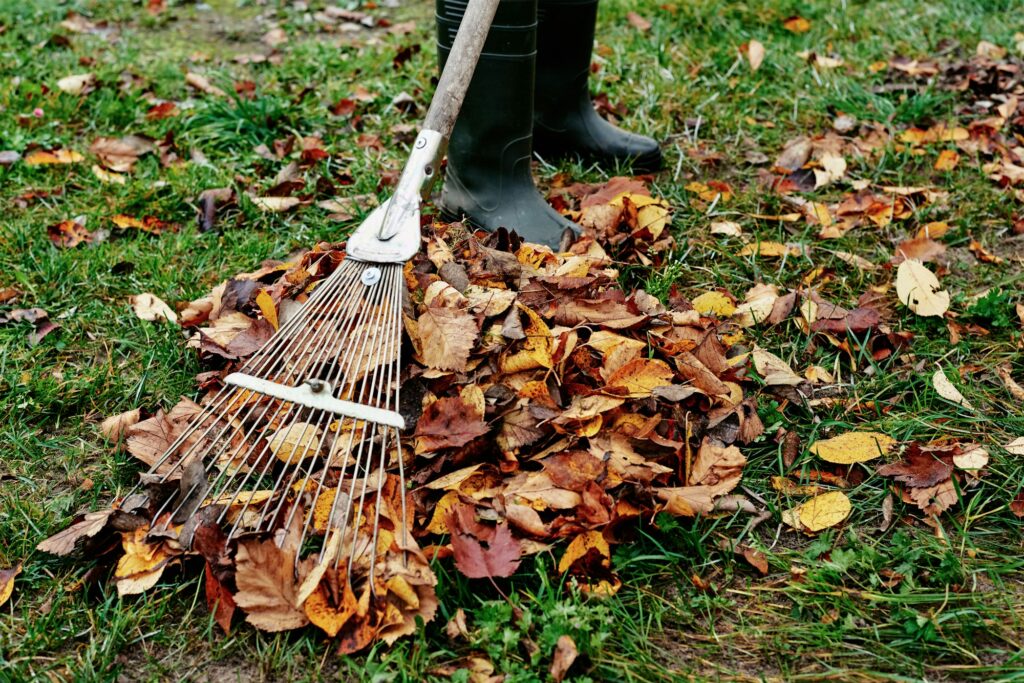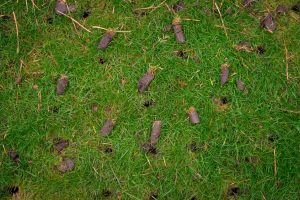
Identifying & Treating Leaf Spot

What Does Leaf Spot Look Like
Leaf spot is a fungal disease that causes yellow, brown, or black spots on a lawn’s grass blades. It can also cause white or tan spots around infected areas. In some cases, these spots may be surrounded by reddish-brown halos. The spots can range in size from small dots to large blotches, and they’ll usually appear in groups.
Aside from the obvious spots you will notice on infected grass blades, another thing you may notice is an hourglass shape of damaged and discolored parts of your grass. As the infection worsens, those discolored spots melt together and eat away at grass blades, causing a thin center where the disease has ravaged the leaf. When this starts happening, you will probably notice larger patches across your lawn becoming generally thinner and weaker.
Key Characteristics:
- Spots of yellow, brown, or black
- Accompanied by a discolored halo
- Discolored shape on grass
- Patches of thin and yellowing turf
- Usually caused by diseased leaves

What Causes Leaf Spot
Leaf spot does not manifest itself in the same way each time it appears; spots will vary in size, color, and severity. In fact, leaf spot is so unique that it can not even be categorized as strictly fungal or bacterial. Whereas most common lawn diseases are caused by invasive fungi, leaf spot can also be contracted by your lawn through a bacterial infection.
Though most leaf spot infections found in residential lawns come from a variety of different fungi, trees and shrubs could fall victim to a bacterial infection, and that bacteria could then be spread to your lawn via infected leaves falling into your yard. If you are dealing with leaf spot as a common fungal lawn disease, there are a number of ways the fungi can spread across your turf, including:
- Unclean tools
- Unraked leaves
- High humidity
- Excess moisture
- Poor drainage
- Excess thatch
- Soil compaction

Leaf spot caused by fungi spreads via spores that are discharged into the air from infected leaves. The spores can travel long distances before eventually landing on leaves or lawns, at which point they’ll cause a new infection. The fungi can also be spread by water, either through rain splashing contaminated water onto healthy leaves or by irrigation systems that are used to water lawns. Once the fungi land on a leaf, they will enter through the stomata, which are tiny pores found on the surface of leaves.
Bacterial leaf spot is spread in a similar fashion, but the bacteria are often carried by insects like aphids or mites. These pests will feed on the sap of infected leaves before moving on to healthy ones, thereby spreading the bacteria and causing a new infection. This is less common for infections that originate on lawns.
Does Leaf Spot Kill Grass?
Unlike some lawn diseases, leaf spot does not confine itself to only warm- or cool-season turf types, meaning you can find it on virtually any lawn where conditions are optimal for the disease to develop. But don’t worry too much, because leaf spot is a foliar disease that will not spread to the vital root system of your lawn. Because of this, leaf spot is generally considered “harmless” for your lawn, and can often be controlled with some very basic treatments.
Remember! The fungal leaf spot disease will not kill your grass, but it can block the sunlight that your lawn needs for photosynthesis. However, bacterial infections, though less common in lawns, can potentially lead to more serious situations that could kill patches of grass. Knowing how to prevent leaf spot is your best bet for defending your turf!

How To Control Leaf Spot
There are a variety of options available for controlling leaf spot, both chemical and non-chemical. Because this disease is so fluid and can attack in so many different ways, the best defense is always going to be maintaining a healthy lawn. A few basic lawn care tasks, carried out on a normal schedule, is usually all that is necessary to prevent the development or stop the spread of the leaf spot lawn disease.
Use A Balanced Fertilizer:
Too much nitrogen in your lawn may make your grass greener, but it will serve as a beacon for leaf spot. Excess nitrogen levels will attract the disease to your lawn, so make sure you are reading labels carefully and never applying too much nitrogen-heavy fertilizer.
Keep Tools Clean:
Since leaf spot is often caused by fallen tree leaves, it makes sense that the tools we use to remove these leaves often become infected themselves. Make sure to clean rakes, mowers, and any other equipment after every use.
Remove Leaves Immediately:
If you have piles of leaves just sitting on your lawn, there is no way of knowing how many of those leaves are sick. This is why it is important to remove leaves as fast as possible if you want to prevent a disease spreading to your lawn.
Water Deeply & Infrequently:
Too much watering can lead to standing water and compaction issues, both of which will invite leaf spot. To combat this, start watering as early in the morning as possible to reduce moisture on your lawn, and opt for longer watering sessions only once or twice per week.
Call In The Pros – If all else fails, we got you covered! Lawn care professionals. Elite Lawn Care, has the products and experience needed to rid your lawn of harmful diseases. Applying fungicide treatments on your own can be very tricky because people often use too much or apply it in the wrong places, which will kill healthy grass blades. Call a lawn care provider near you for more tips and tricks to keep your lawn healthy!
Start Your Quote Today! Getting Started
Get your weekend back & simplify your life this season. Trust Elite Lawn Care for your Lawn Care, Landscaping & Snow Removal needs.
-
1Choose Your ServicesChoose the services your property needs throughout the year.
-
2Set Up & Finalize Your AccountFill out the form & one of our team members will contact you.
-
3Discover The DifferenceServices are automatically scheduled, completed & billed.










